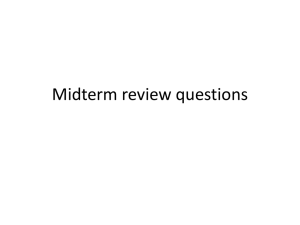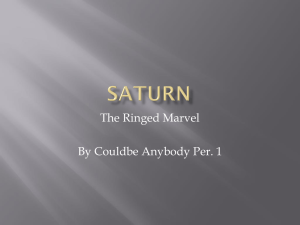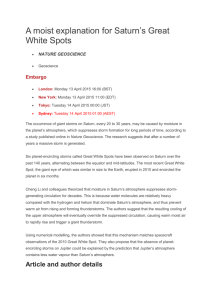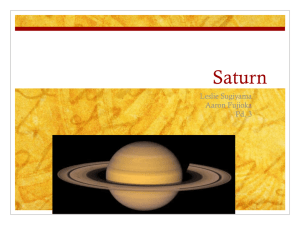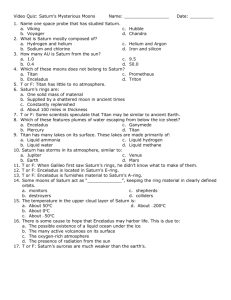Anthony's Everything About Saturn
advertisement
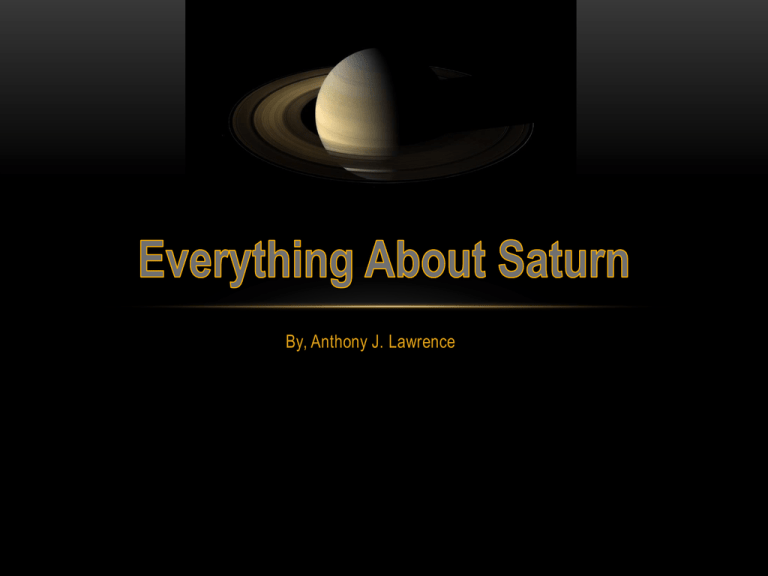
By, Anthony J. Lawrence • Saturn’s symbol is thought to be an ancient scythe or sickle. • Saturn’s name came from the Roman god of agriculture and time. • Saturn in Latin is “Saturni” and in the English language it means “Saturday.” • Who discovered it? The planet was known by the ancients. • When did they discover Saturn? Unknown • How was Saturn discovered? People on earth can see Saturn with the naked eye however, the first observation of Saturn through telescope was by Galileo in 1610. • Mass: 568,319,000,000,000,000,000,000,000 it could also be written as 568,319 x 10 21. • Volume: 827,129,915,150,897 km 3. • Density: 0.687g/cm 3. • Gravity: (Metric) 10.4* m/s 2, (English) 34.3 ft./s2. • Sink or float? In water Saturn would float because it has a density less than water’s, which is 1.00 • Saturn is the 6th planet from the Sun. Since it is the 6th planet from the sun is it 1.4 billion km. Lastly, Saturn is more or less than 1,300,000,000km far Earth • 1 year on Saturn is equivalent to 29 years on Earth. • It takes Saturn 10.7 hours to rotate on its own axis • Saturn is a gas giant. Due to Saturn being a gas giant it does not have a solid surface. • Saturn has a core composed of rock, ice, water, and other minerals, made by intense pressure and heat. • Saturn has blue, brown, tan, green, gray, and golden hues. It has a magnificent ring system. Many time scientist can see Aurora on the planets through telescopes. • Saturn’s atmosphere is made up of three components. Those components are Hydrogen, Helium, and Methane. • 97% Hydrogen. • 3% Helium • 0.05% Methane • The mean temperature, at the tops of clouds, on Saturn is 88 Kelvin(K) (-185°C; -290°F). Compared to Earth and Florida no temperatures as cold as 88K have ever been reached on Earth. • Winds, in the equatorial region, reach 500 meters (1,600 feet) per second. • There are seven rings, whit different gaps and division in between them. The gaps were discovered by Giovanni Cassini, in the 17th century. • Galileo discovered the rings • The rings are 270,000 km in diameter and a few hundred meters thick. • They are made up of rocks, ice, silicate, and carbon minerals • Colors: yellow, gold, brown, gray (mainly) • A form of water on Saturn is ice. • This ice was created due to the extreme cold on Saturn’s surface and atmosphere • There are 53 moons, plus 9 more awaiting discovery, that revolves around Saturn. • Some of Saturn’s moons may be capable to support life. • A famous moon of Saturn is Titan. Titan is the biggest moon of Saturn’s moons; has a cold, thick, and hazy atmosphere, with temperature as low as -297°F, and Titan Is 745,000miles away from Saturn. • Another one of Saturn’s moons is Phoebe. • Phoebe is 8,049,668 miles away from Saturn, I is roughly spherical, and is very dark. Phoebe reflects 6% of sunlight, and was discovered by William Pickering, August 1898. • If a human traveled to Saturn they would definitely choke on the atmosphere. They would choke because Saturn’s atmosphere contain NO OXYEGEN. • The gravity on Saturn would have little affect on a human because Saturn’s gravitational weight is 1.08 relative to Earth’s 1.00. A 100lbs person would weigh 108lbs on Saturn. • On Saturn a human would burn up so if you are planning on going, bundle up! Cassini • 5 missions have been sent to Saturn since 2004. The Cassini spacecraft has been exploring Saturn’s rings and moons. • Pioneer 11 was the first spacecraft to fly by Saturn in 1979 • Saturn radiates 79% more energy than it receives from the sun. • Most flattened planet in our solar system • Saturn has no volcanoes, 100-year-long storms; robots have never been to the planet. Pioneer 11 • World to the Universe. http://www.windows2universe.org/saturn/saturn.html, 2010 • Lunar and Planetary Institute. Solar System Exploration. http://solarsystem.nasa.gov/multimedia/display.cfm?IM_ID=167. • Solar System Exploration: Planets. http://solarsystem.nasa.gov/planets/profile.cfm?Object=Saturn&Display=Facts&System=M etric • Saturn: Planet Profile. http://pds.jpl.nasa.gov/planets/special/saturn.htm. • Bill Arnett. Appendix 5: Planetary Linguistics. http://nineplanets.org/days.html#days, 2013 • All About Astronomy. http://www.enchantedlearning.com/subjects/astronomy/planets/saturn/saturninside.shtml , 1999 FOR VIEWING MY POWER POINT



